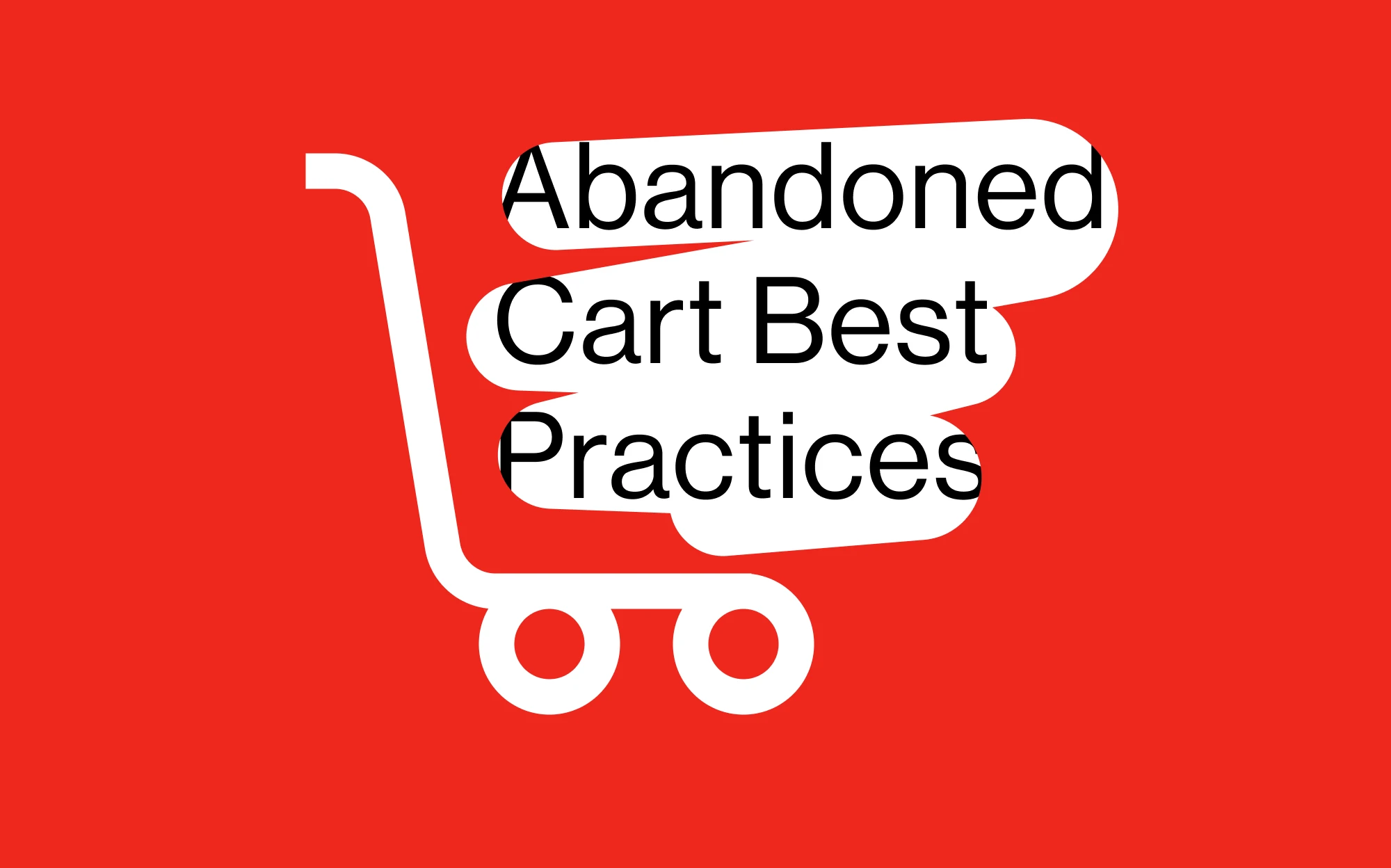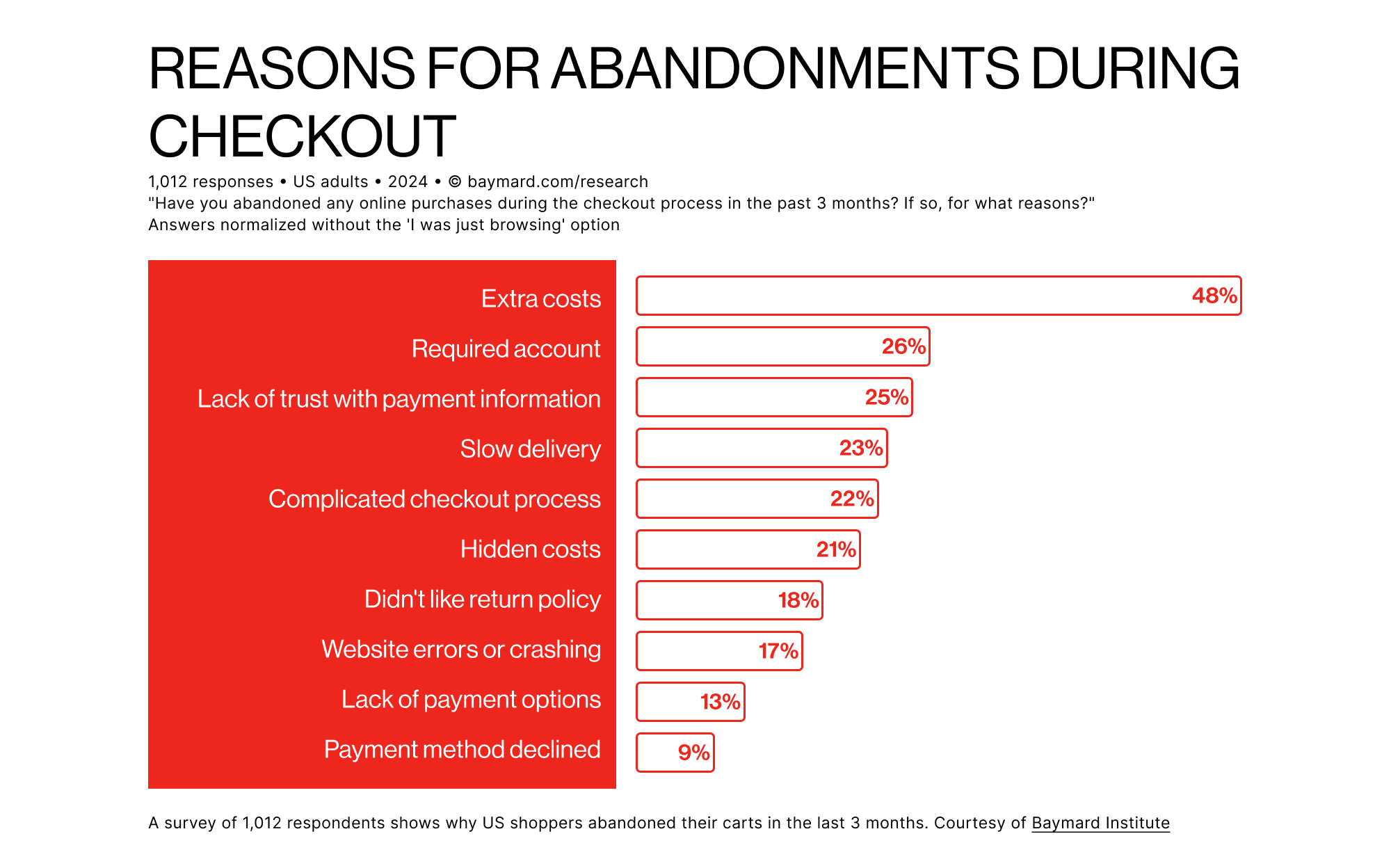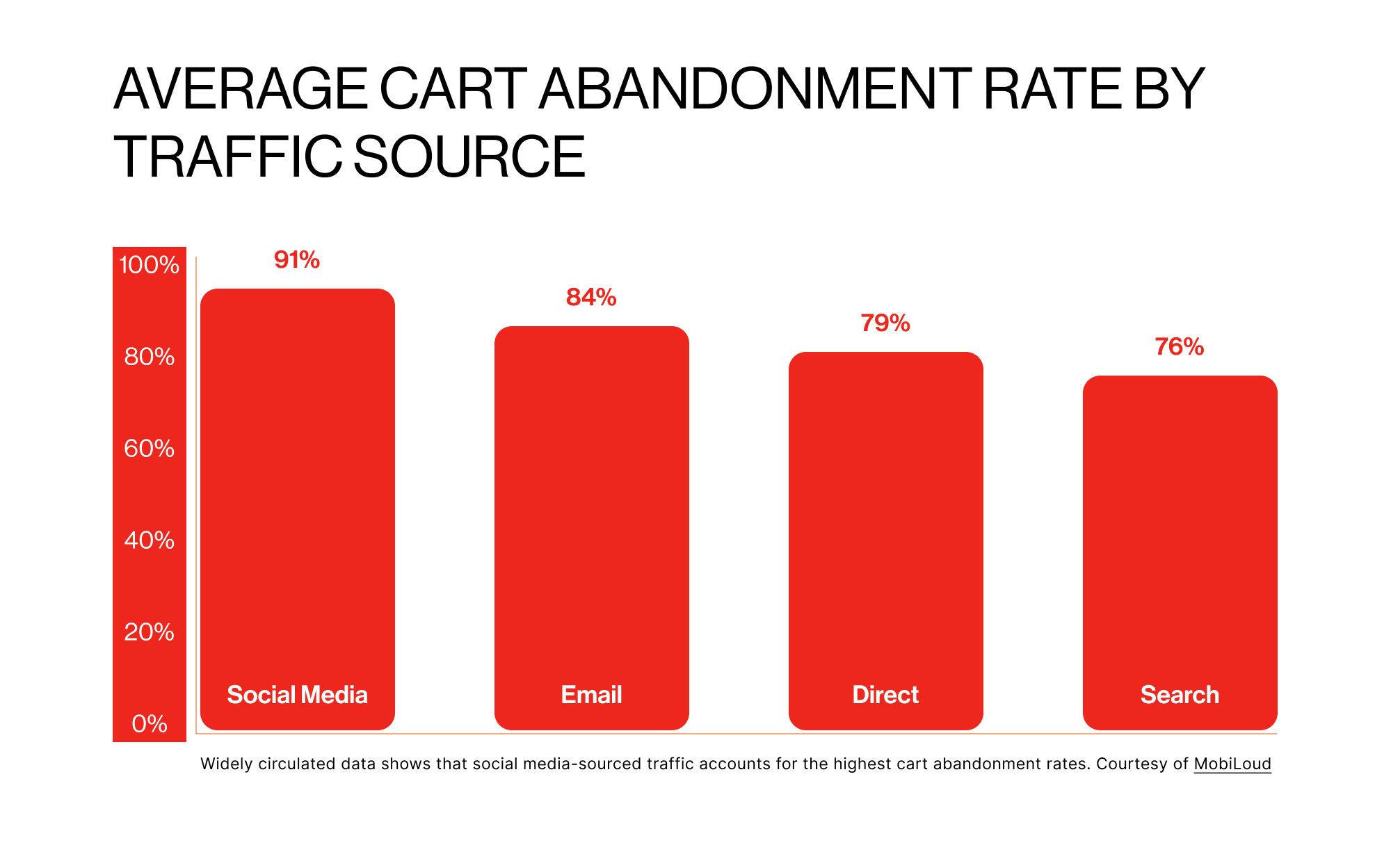
How to Stop Shopping Cart Abandonment
It’s a tale as old as eCommerce: your visitors browse around, add items to their cart, get to the payment window, and stop. They leave the site, their cart full of items, and you the salesman are left wondering what happened.
What causes your customers to get cold feet at the last moment, just before they make a purchase? Whatever the reason, data shows that over $4 trillion is lost to abandoned carts every year, but as much as $260 billion of that amount is recoverable.
Abandoned shopping carts are more common than you might think. We’ll be covering ways to not only reduce abandoned cart rates, but how to get those fickle shoppers back on your website to complete their purchase.
What is Shopping Cart Abandonment Rate?
A shopping cart abandonment rate represents how often customers on your website add items to their cart only to stop shopping, leaving their carts and items behind.
They are incredibly common, with nearly 70 percent of shoppers online abandoning their carts before finalizing their purchase. That means that just 3 out of every 10 shoppers commit to a purchase after adding items to their cart, and this metric is not limited to small online storefronts or startups: Amazon and Target, both representing some of the largest and most profitable online stores, experience an abandoned cart rate in line with the 70 percent average.
You may be wondering how to improve cart abandonment rates in the short term, but the simple fact is that you cannot: abandoned shopping cart rates are fairly consistent across the board and for all companies.
That said, you can still do something about it through extra measures, follow-ups, and timing. First, we’ll explore what causes cart abandonment, then discuss some options for mitigating these rates.
What Causes Shopping Cart Abandonment?
There’s no one answer for what causes a person to abandon their carts. The factors that influence this rate include the time of month, how easy it is to finalize purchases on your website, the cost of the item, what device they’re using to shop, and how committed your shoppers are when they arrive on your website.
If you’re wondering how to improve cart abandonment rates at your company, keep reading, because we’ll be covering some methods after this section. Just understand that abandoned cart rates of 70 percent are the industry standard, so you’ll be mitigating that rate after the fact in most cases.
Shoppers will Likely Abandon Their Shopping Cart
We’ve said it before, and we’ll say it again: 70 percent of shoppers will abandon their cart regardless of your efforts. In fact, cart abandonment generally grows year after year as the internet marches on into maturity, and people are more likely to do research, compare prices, and ‘save’ items before committing to a purchase.
According to the Baymard Institute, which conducts studies on user experiences and eCommerce, this is a consequence of how people shop online. They window shop, compare prices (more on this later), save purchases for later, look for gift options, and more. Don’t fear this number, high as is it; most people who abandon their carts will come back if given the right push.
What is important to remember is that the 70 percent abandonment rate average is one that comes after most companies have made efforts to mitigate that number. 70 percent is the goal, and without doing anything to help your shoppers and improve your shopping experience, your rate will likely be even higher.

Desktop Rates are Lower, but Not by Much
Desktop users will often have the most premium experience available when they’re shopping online. Speeds tend to be faster, the screen is larger, and input methods are simply more precise. Regardless of this, 73 percent of desktop shoppers will abandon their cart, and this is the lowest percentage when compared to shoppers on other devices.
Mobile users jump to a percentage of over 85 percent. This is especially alarming when paired with the fact that over two-thirds of eCommerce sessions originate on mobile devices. Besides highlighting why it's important to remember your desktop shoppers, these metrics point to why high speeds and UX refinement are so important on mobile-optimized websites. 85 percent is, again, AFTER measures have been taken to mitigate cart abandonment rates.
High Prices = High Abandonment Rates
If you’re selling a high-priced item, expect people to abandon their carts in even larger numbers. Some of the highest cart abandonment rates exist in industries like home furnishings (90 percent), automotive (86 percent), and jewelry (84 percent.) In comparison, some of the lowest rates include purchases of groceries (just 50 percent), medicine and pharmaceuticals, and cosmetics.
Think of it as luxury vs necessity. People are more likely to buy things they need rather than upgrade existing items or purchase new ones, especially if those items cost more than $100. Some of this has to do with the average salaries of your shoppers, but more often, you will see these customers return closer to when paychecks start to arrive at the end of the month. Do your due diligence in follow ups and streamlining, and your cart abandonment rate won’t impact your revenue as much as you think.
Social Media is a Great Traffic Source, but Abandonment Rates are High
Social media will get people on your website, period. A study from the ODM Group marketing agency found that nearly 3 out of every 4 people allow social media to inform their purchasing decisions, while a Hubspot report found that 71 percent of people are more likely to visit an eCommerce site if referred by their social media channels. If traffic is what you’re looking for, social media is a must, but for eCommerce sites, social media referrals will likely result in window shopping.

Over 91 percent of shoppers who arrived on the site via Social Media abandoned their carts, likely because these users were researching or browsing when they found your link. Compare this to Search, where a shopper is likely on the hunt for something to buy, and you can see that cart abandonment falls closer to the industry average.
The importance of social media click-throughs is to create awareness of your product so people can find it later when they are in a ‘buying mood’, so again, don’t worry so much about the abandonment rate, and focus more on what getting people on your website does in the long term.
People Commit at The End of Every Month
Most people receive their salaries on a biweekly or monthly basis, and this frequency directly corresponds to when people follow through with online purchases. People try not to spend money they don't have on items considered to be optional, which means most people browsing or finding your online storefront in the early or mid-month are saving items for later purchase or investigating the prices you’re offering.
While there is little you can do to improve the rate itself, this data can help you design personalized marketing to target your abandoned cart users. You can remind them around these times of the month that they have pending purchases, and if initial impressions were good, they are more likely to take you up on that offer. We'll discuss the effectiveness of reminder emails later.
Hidden Costs Increase Abandonment Rates
If you live in the United States, you are likely familiar with the ‘hidden cost’ associated with every purchase you make: sales tax. For those not in the USA, items are typically priced at close to a dollar (ex:$14.99) and at checkout, that price rises to reflect the sales tax (in California, sales tax is 7.25%, resulting in a total of $16.08). This hidden-cost ‘tradition’ has bled into the world of eCommerce, but your shoppers hate it.
Extra costs that arrive when checking out lead to over 48 percent of online shoppers abandoning their cart in 2022, according to a Baymard Institute study. Those costs typically include tax, but also shipping, customs fees, and more. A further 16 percent of surveyed users said that because they couldn’t calculate this amount upfront, they decided to shop elsewhere.
The best way to mitigate this is to be upfront about the costs involved. Show that shipping will be added, even on the product page, and calculate it when the shopper offers you a delivery address. Make sure you are also including sales tax, which should be consistent based on your location. The goal is to make the user feel like they’re in control and that they are informed well before they get to the point they’re pulling out their credit card.
|
Guest Accounts Increase Sales by 24%
Have you ever gone to a website, loaded up your cart, and arrived on the purchase page only to find out you’ll have to go through the often-painful process of creating an account? You’ll be receiving an email, checking your spam to find that email, clicking a confirmation link, adding a payment method, and only then will you be allowed to make a purchase. Imagine if shopping at brick and mortar stores required a survey before every purchase.
It’s no surprise that making guest accounts available, especially if you’re selling a niche or long-term product, increases your chances of a successful sale. While having a personalized account makes sense from the standpoint of creating a repeat customer, you should offer this, not make it a necessity if possible. It is important that the customer feels unburdened while making a purchase.
Instead of forcing an account creation, offer benefits that serve to make future checkouts even easier. Offer to remember payment details upon account creation, or a ‘1-click-purchase’ button. These can be especially potent if you're selling reusables or necessities. Also remember to offer multiple shipping and payment options, as around 9 percent of users cite this as a reason for abandoning their cart. Most ‘bigbox’ online retailers offer these options to make the checkout experience easier for their customers, and you should select an eCommerce platform that offers multiple payment and shipping options when designing your own storefront.
Make Sure Your Website Works Well and Looks Professional
The stats tell the story: 18 percent of shoppers cited lack of trust when giving out credit card information as a reason for abandoning their cart. 17 percent said that the checkout process was too complicated or requested too much information, and 12 percent said they didn’t like the return policy. 13 percent said that the website crashed or had too many errors to proceed.
Make sure you have website best practices in place, like snappy load times, small image and video file sizes, mobile optimization, and clear navigation. Having a website that feels like it was designed by professionals will make your shopping experience more trustworthy and give your shoppers a feeling of control. Remember to be flexible about payment options, shipping methods, and return policies as well.
How to Reduce Shopping Cart Abandonment Rates
The most common and effective methods, besides a refined and robust checkout process, are marketing and email reminders. You can also use abandoned cart best practices to nudge this percentage down even further.
To reiterate, the very nature of the internet makes it so your cart abandonment rates will only ever get to around 70 percent, and any percentage you find through your website metrics that is lower than that is considered outstanding. Here are the primary methods you can use to get people back on your website, and back to their abandoned cart.
Email Reminders
Emails are the go-to solution for recovering lost revenue from abandoned carts, and small wonder: abandoned cart reminder emails are considerably more effective than almost all other types of email marketing campaigns.
A report from SaleCycle reported that customers opened 40 percent of abandoned cart email reminder emails, which is nearly double the average open rate of around 21 percent. Furthermore, the clickthrough rate on abandonment emails is more than 23 percent, which is almost 10 times higher than the average of 2.5 percent. Simply by following up, you can see measurable results with customers returning to their abandoned carts.
The sweet spot for the amount of reminder emails to send is three. An exhaustive 2017 report from Klaviyo that measured millions of cart abandonment emails and their performance revealed that one followup email resulted in around $3.8 million in recovered revenue, but three emails resulted in more than $24.9 million. Interestingly, two emails resulted in the second best revenue recovery, while four emails resulted in higher clickthrough rates, but when considering the best cost-to-revenue ratio, three emails remains king.
Target Ads to Reflect Customer Choices
Retargeting ads are paid posts and ads online that remind customers of their abandoned cart, usually accompanied by language like “you forgot the check out!” and “finish your purchase and get 15% off!” They are the best answer to the question of “how to convert abandoned carts?”, and have become standard practice in most marketing strategies because they usually attract a much higher clickthrough rate than non-targeted ads, some as high as 76 percent more likely to get a click.
Retargeted ads use cookies and tracking pixels to get ads to shoppers at the right time to spark a conversation. That includes sending out such ads near the end of the month when people receive their paycheck, or near holidays when people are trying to think of gift ideas. If you can afford it, taking a small percentage off the total price is always a powerful method to instill urgency and a fear of missing out on a great deal.
Use Abandoned Cart best practices
While it’s difficult to reduce your abandoned cart rate below the industry standard, there are still methods for making sure it does not surpass it. Here is a simple and straightforward list of what you should do to keep your abandoned cart rate low, and your recovered revenue high.
Honest Pricing
Make sure your site displays all costs as soon as possible for the user. Costs that appear in the checkout window are likely to increase bounce rates. That includes taxes, shipping, and additional fees.
Simple Checkout
Make your checkout process easy, fast, and simple. The more steps between clicking the cart button and getting a purchase confirmation you have, the more likely you are to lose the customer. Autofill options, one-click buy buttons, and a reduced number of steps are all good options, but do not force your customers to create an account to make a purchase if possible.
Offer Multiple Payment Options
Offer multiple ways to make purchases for your customers. Credit cards are standard, but have options for popular payment portals and services like Apple Pay, Google Pay, Braintree, Paypal, Stripe, Revolute, or Paytabs. Including options for cash-on-delivery (COD) or Point of Service (POS) on delivery are also a plus.
Build Trust
Include images and links to security certifications that you might have to show you take payment information security seriously. Also include user reviews to show that you stand by your product and listen to customer feedback.
Make Refund, Return Information Clear
Make sure your refund and cancellation policies are displayed or easily located so that your customers will understand what you are prepared to do in the event of a mistake or defective product. Be gracious and generous in your customer interactions, as they go a long way to leaving a positive impression, which can potentially lead to positive reviews.
Manage Your Inventory
Nothing is more annoying for your customers than finding out the item they ordered will be late or may not show up at all. Prevent this by having a clear understanding of what you have available for sale, then present that information to the customer while they’re shopping. A bonus side effect of a real-time inventory display is that if there are only a few items left, it can instill a sense of urgency in your customers, prompting spontaneous sales.
Be Open to Customer Interactions
A clear button that opens a chat popup shows your customers that you are ready and waiting to help them with any questions they might have. Most websites do this by having a small button in the lower right corner that, when tapped, immediately opens a support chat. You can further enhance this experience, and save money, by employing an AI-assistant that can answer common questions or guide customers to what they are looking for.
Conclusion
Abandoned cart rates are an unfortunate reality of doing business online and there is very little you can do to bring that number down below 70 percent. Customers shopping online are typically browsing and are interested in learning how you stack up against the competition. They do research outside your site, look up customer reviews, and usually only fill a cart to get an estimate, especially at the beginning of the month. All of this leads to lonely items, sitting in a cart online, waiting to be purchased.
As we discussed, the correct approach to this issue is not lowering the abandonment rate, but increasing your return rate. Remind your customers of their purchases through email and retargeting ad campaigns, and sweeten the deal if possible. Make customer reviews and support channels available directly on your site so they don’t have to leave or compare your offerings to your competitors. Make checkout easy, transparent, and responsive to give your customers the same robust and snappy experience across all devices.
In a word, you need to build trust. Once you build trust, your emails will be welcome and your ads will be taken seriously. Soon your abandoned cart rate will be nothing more than a number.
Related posts
446,005 entrepreneurs like you already have a head start
Become one of them by getting world-class expertise delivered into your inbox, for free.












